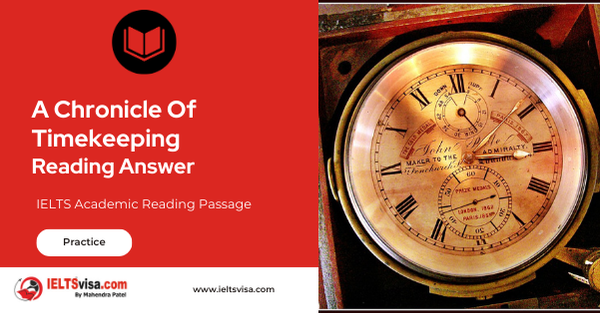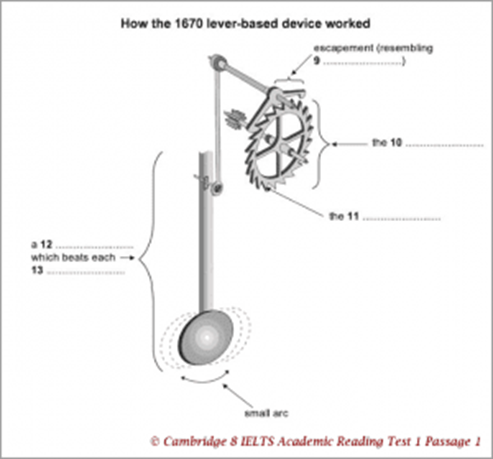A Chronicle Of Timekeeping Reading Answer
IELTS Academic Reading Passage
Our conception of time depends on the way we measure it
A
According to archaeological evidence, at least 5,000 years ago, and long before the advent of the Roman Empire, the Babylonians began to measure time, introducing calendars to co-ordinate communal activities, to plan the shipment of goods and, in particular, to regulate planting and harvesting. They based their calendars on three natural cycles: the solar day, marked by the successive periods of light and darkness as the earth rotates on its axis; the lunar month, following the phases of the moon as it orbits the earth; and the solar year, defined by the changing seasons that accompany our planet’s revolution around the sun.
B
Before the invention of artificial light, the moon had greater social impact. And, for those living near the equator in particular, its waxing and waning was more conspicuous than the passing of the seasons. Hence, the calendars that were developed at the lower latitudes were influenced more by the lunar cycle than by the solar year. In more northern climes, however, where seasonal agriculture was practised, the solar year became more crucial. As the Roman Empire expanded northward, it organised its activity chart for the most part around the solar year.
C
Centuries before the Roman Empire, the Egyptians had formulated a municipal calendar having 12 months of 30 days, with five days added to approximate the solar year. Each period of ten days was marked by the appearance of special groups of stars called decans. At the rise of the star Sirius just before sunrise, which occurred around the all- important annual flooding of the Nile, 12 decans could be seen spanning the heavens. The cosmic significance the Egyptians placed in the 12 decans led them to develop a system in which each interval of darkness (and later, each interval of daylight) was divided into a dozen equal parts. These periods became known as temporal hours because their duration varied according to the changing length of days and nights with the passing of the seasons. Summer hours were long, winter ones short; only at the spring and autumn equinoxes were the hours of daylight and darkness equal. Temporal hours, which were first adopted by the Greeks and then the Romans, who disseminated them through Europe, remained in use for more than 2,500 years.
D
In order to track temporal hours during the day, inventors created sundials, which indicate time by the length or direction of the sun’s shadow. The sundial’s counterpart, the water clock, was designed to measure temporal hours at night. One of the first water clocks was a basin with a small hole near the bottom through which the water dripped out. The falling water level denoted the passing hour as it dipped below hour lines inscribed on the inner surface. Although these devices performed satisfactorily around the Mediterranean, they could not always be depended on in the cloudy and often freezing weather of northern Europe.
E
The advent of the mechanical clock meant that although it could be adjusted to maintain temporal hours, it was naturally suited to keeping equal ones. With these, however, arose the question of when to begin counting, and so, in the early 14th century, a number of systems evolved. The schemes that divided the day into 24 equal parts varied according to the start of the count: Italian hours began at sunset, Babylonian hours at sunrise, astronomical hours at midday and ‘great clock’ hours, used for some large public clocks in Germany, at midnight. Eventually these were superseded by ‘small clock’, or French, hours, which split the day into two 12-hour periods commencing at midnight.
F
The earliest recorded weight-driven mechanical clock was built in 1283 in Bedfordshire in England. The revolutionary aspect of this new timekeeper was neither the descending weight that provided its motive force nor the gear wheels (which had been around for at least 1,300 years) that transferred the power; It was the part called the escapement. In the early 1400s came the invention of the coiled spring or fusee which maintained constant force to the gear wheels of the timekeeper despite the changing tension of its mainspring. By the 16th century, a pendulum clock had been devised, but the pendulum swung in a large arc and thus was not very efficient.
G
To address this, a variation on the original escapement was invented in 1670, in England. It was called the anchor escapement, which was a lever-based device shaped like a ship’s anchor. The motion of a pendulum rocks this device so that it catches and then releases each tooth of the escape wheel, in turn allowing it to turn a precise amount. Unlike the original form used in early pendulum clocks, the anchor escapement permitted the pendulum to travel in a very small arc. Moreover, this invention allowed the use of a long pendulum which could beat once a second and thus led to the development of a new floorstanding case design, which became known as the grandfather clock.
H
Today, highly accurate timekeeping instruments set the beat for most electronic devices. Nearly all computers contain a quartz-crystal clock to regulate their operation. Moreover, not only do time signals beamed down from Global Positioning System satellites calibrate the functions of precision navigation equipment, they do so as well for mobile phones, instant stock-trading systems and nationwide power-distribution grids. So integral have these time-based technologies become to day-to-day existence that our dependency on them is recognised only when they fail to work.
Questions 1-4
Reading Passage has eight paragraphs, A-H.
Which paragraph contains the following information?
Write the correct letter, A-H, in boxes 1-4 on your answer sheet
- a description of an early timekeeping invention affected by cold temperatures 1…………………
- an explanation of the importance of geography in the development of the calendar in farming communities 2…………………
- a description of the origins of the pendulum clock 3…………………
- details of the simultaneous efforts of different societies to calculate time using uniform hours 4…………………
Questions 5-8
Look at the following events (Questions 5-8) and the list of nationalities below. Match each event with the correct nationality, A-F.
Write the correct letter, A-F, in boxes 5-8 on your answer sheet.
List of Nationalities
A Babylonians
B Egyptians
C Greeks
D English
E Germans
F French
5. They devised a civil calendar in which the months were equal in
6.They divided the day into two equal
7.They developed a new cabinet shape for a type of
8.They created a calendar to organise public events and work
Questions 9-13
Label the diagram below.
Choose NO MORE THAN TWO WORDS from the passage for each answer. Write your answers in boxes 9-13 on your answer sheet.
How the 1670 lever-based device worked
- ………………..
- ………………..
- ………………..
- ………………..
- ………………..

Solution:A Chronicle Of Timekeeping Reading Answer
- D
- B
- F
- E
- B
- F
- D
- A
- (ship’s) anchor/(an/the) anchor
- (escape) wheel
- tooth
- (long) pendulum
- second
Review and Practice
- Regularly practice with IELTS reading samples and time yourself to get used to the pressure of the exam.
- Review your mistakes to understand where you went wrong and how to avoid similar errors in the future.
Our Books
Master IELTS Speaking Part 1
IELTS Writing Task 1 Book
IELTS Writing Task 2 Book
A Chronicle of Timekeeping Reading Answer Explanation
| Question NO | Question Types | Answer | Keywords | Location of keywords | Explanations |
|---|---|---|---|---|---|
| 1 | Solution With Explanation | D | inventors created sundials, could not always be depended on, cloudy, freezing weather, northern Europe | Paragraph D | Paragraph D refers to the fact that in order to track temporal hours during the day, inventors created ‘sundials’ (an early timekeeping invention), which indicate time by the length or direction of the sun’s shadow. The ‘sundial’s counterpart, the water clock’, was designed to measure temporal hours at night. Although these devices performed satisfactorily around the Mediterranean, they ‘could not always be depended on in’ the cloudy and often ‘freezing weather of northern Europe’. |
| 2 | Solution With Explanation | B | northern climes, seasonal agriculture, solar year, more crucial | Paragraph B | Paragraph B informs that before the invention of artificial light, the ‘moon had greater social impact’. For those ‘living near the equator’, its waxing and waning was more conspicuous than the passing of the seasons. The ‘calendars developed at lower latitudes’ were influenced more by the lunar cycle than by the solar year. In more northern climes, however, where ‘seasonal agriculture’ was practised, the solar year became more crucial. |
| 3 | Solution With Explanation | F | 16th century, pendulum clock, devised, swung in a large arc, not very efficient | Paragraph F | Paragraph F mentions that by the 16th century, a ‘pendulum clock had been devised’, but it swung in a large arc and thus was not very efficient. Hence, the answer is F. |
| 4 | Solution With Explanation | E | question, when to begin counting, early 14th century, number of systems evolved | Paragraph E | Paragraph E shares that in the early 14th century, ‘a number of systems evolved’. The schemes that divided the day into ‘24 equal parts’ varied according to the start of the count: ‘Italian hours’ began at sunset, ‘Babylonian hours’ at sunrise, astronomical hours at midday, and ‘great clock’ hours at midnight. |
| 5 | List of Nationalities | B | before the Roman Empire, Egyptians, municipal calendar, 12 months of 30 days, five days added, approximate, solar year | Paragraph C | In paragraph C, it is noted that centuries before the Roman Empire, the ‘Egyptians’ had formulated a ‘municipal calendar’ with ‘12 months of 30 days’, with five days added to approximate the solar year. |
| 6 | List of Nationalities | F | French, hours, split the day into two 12-hour periods commencing at midnight | Paragraph E | Paragraph E indicates that eventually, the ‘schemes that divided the day into 24 equal parts’ were replaced by ‘small clock’, or French hours, which split the ‘day into two 12-hour periods’ starting at midnight. |
| 7 | List of Nationalities | D | this invention allowed the use of, timekeeper, cabinet shape | Paragraph G | Paragraph G mentions that a variation on the original escapement was invented in 1670, in England, called the anchor escapement. It allowed the use of a long pendulum which led to the ‘development of a new floorstanding case design’, known as the grandfather clock. |
| 8 | List of Nationalities | A | Babylonians, measure time, calendars, coordinate communal activities, plan, shipment of goods, regulate planting, harvesting | Paragraph A | Paragraph A reveals that long before the Roman Empire, the ‘Babylonians’ began to measure time, introducing calendars to ‘coordinate communal activities, plan the shipment of goods, and regulate planting and harvesting’. |
| 9 | Label the diagram below | (ship’s) anchor | anchor escapement, lever-based device, ship’s anchor, catches releases each tooth, escape wheel | Paragraph G | Paragraph G discusses the anchor escapement, a lever-based device shaped like a ship’s anchor. |
| 10 | Same As 10 | (escape) wheel | Same As 10 | Same As 10 | Paragraph G describes how the pendulum rocks the device, catching and releasing each tooth of the escape wheel. |
| 11 | Label the diagram below | tooth | allowed the use of a long pendulum, beat once a second | Paragraph G | Paragraph G conveys that a long pendulum which could beat once a second led to the grandfather clock’s design. |
| 12 | Label the diagram below | (long) pendulum | beat once a second | Same as 11 | Paragraph G explains that the long pendulum, enabled by the anchor escapement, could beat once a second, influencing clock design. |
Practice IELTS Other Modules
IELTS Listening
The IELTS Listening test assesses how well you can understand spoken English in various contexts. It lasts about 30 minutes and is divided into four sections with a total of 40 questions. The listening tasks become increasingly difficult as the test progresses.
IELTS Academic Reading
The IELTS Academic Reading section assesses your ability to understand and interpret a variety of texts in academic settings. It is designed to evaluate a range of reading skills, including skimming for gist, reading for main ideas, reading for detail, understanding inferences, and recognizing a writer's opinions and arguments.
IELTS Speaking
The IELTS Speaking test assesses your ability to communicate in English on everyday topics. It lasts 11-14 minutes and consists of three parts: introduction, cue card, and a discussion based on the cue card topic.
IELTS General Reading
IELTS General Reading tests your ability to understand and interpret various types of texts. Here are some key areas and types of content you can expect to encounter in the reading section, along with tips for effective preparation.
IELTS Academic Writing Task 1
In IELTS Academic Writing Task 1, you are presented with a visual representation of information, such as graphs, charts, tables, or diagrams, and you are required to summarize, compare, or explain the data in your own words.
IELTS General Writing Task 1
In IELTS General Writing Task 1, you are required to write a letter based on a given situation. The letter can be formal, semi-formal, or informal, depending on the prompt. Here’s a breakdown of the key components to include in your letter
IELTS Academic Writing Task 2
In IELTS Academic Writing Task 2, you are required to write an essay in response to a question or topic. Here’s a guide to help you understand the essential elements of this task
IELTS Exam Tips
To succeed in the IELTS exam, practice regularly, familiarize yourself with the test format, improve your vocabulary, develop time management skills, and take mock tests to build confidence.
Grammer for IELTS
Grammar is the foundation of effective communication in English. Understanding tense usage, subject-verb agreement, and sentence structure enhances clarity and coherence in writing and speaking.
Vocabulary for IELTS
Vocabulary plays a crucial role in the IELTS (International English Language Testing System) exam, especially in the Speaking and Writing sections. Here’s an overview of why vocabulary is important and how it impacts your performance
RECENT IELTS SAMPLES QUESTIONS AND ANSWERS
Walking with dinosaurs
Peter L. Falkingham and his colleagues at Manchester University are developing techniques that...
Money as the Unit of Amount Reading Answers
The most difficult aspect of money to understand is its function as a unit of account. In...
WEATHERING IN THE DESERT
In the deserts, as elsewhere, rocks at the earth's surface are changed by weathering, which...
Nature on Display in American Zoos
The first zoo in the United States opened in Philadelphia in 1874, followed by the Cincinnati...
Can We Prevent the Poles From Melting
Such is our dependence on fossil fuels, and such is the volume of carbon dioxide we have...
Air conditioning the earth reading answers
The circulation of air in the atmosphere is activated by convection, the transference of heat...













